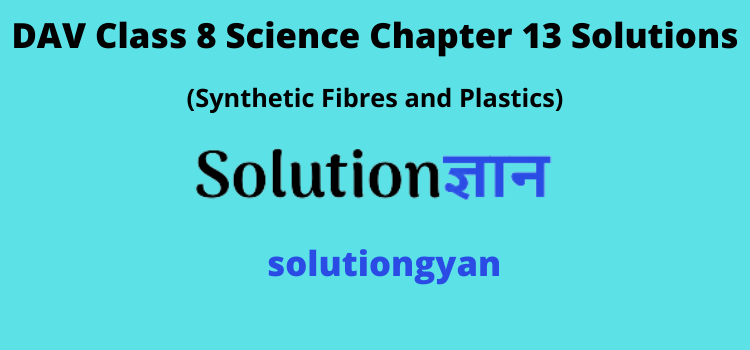DAV Class 8 Science Chapter 13 Solutions Synthetic Fibres and Plastics of The Living World Science Book is extremely crucial for the students studying in DAV Class 8 Science. The DAV Solutions for Class 8 Science of Chapter 13 Synthetic Fibres and Plastics are provided here to help the students to clear all their doubts and to help them in understanding the chapter in an easy and interesting way.

These DAV Solutions present you with answers to the question on the synthetic fibres and plastics. While solving the DAV textbook questions, students often face several doubts and eventually get confused. To help the students clear all their doubts instantly, the DAV Class 8 Science Chapter 13 Synthetic Fibres and Plastics Solutions come as a great resource. Here, the detailed Solutions for Class 8 Science Chapter 13 of DAV Class 8 Science book are given below.
Synthetic Fibres and Plastics: DAV Class 8 Science Chapter 13 Solutions
DAV Class 8 Science Chapter 13 Synthetic Fibres and Plastics Question Answer is given below. Here DAV Class 8 Science Chapter 13 Question Answer is provided with great explanation.
Highlights
- Fill in the blanks
- True or False
- Tick the correct option
- Answer the following questions in brief
- Answer the following questions
These DAV Class 8 Science Chapter 13 Synthetic Fibres and Plastics Solutions will help you in scoring good marks as they cover important concepts in different patterns like fill in the blanks, tick the correct option, True or False for the following statements, short answer questions, long questions answer and more.
A. Fill in the blanks.
1. ___________ and ___________ are examples of natural fibres.
2. The simplest molecule of a polymer is known as a ___________.
3. Rayon is also known as a ___________ fibre.
4. Nylon is a ___________ fibre.
5. ___________ plastics cannot be remoulded again on heating.
Answer: (1) Cotton, wool (2) monomer (3) regenerated (4) synthetic (5) Thermosetting
B. Write True or False for the following statements.
1. Natural fibres are highly resistant to the effects of chemicals like acids and alkalis.
2. Synthetic fibres absorb very little water.
3. Thermoplastics can be easily remoulded on heating.
4. The plastic, used for insulating electrical wires, is teflon.
5. All types of plastics are biodegradable.
Answer: (1) False (2) True (3) True (4) True (5) False
C. Tick the correct option.
1. The correct choice, for the box, in the following sequence, is thermoplastic: PVC; thermosetting plastic: ?
Answer: bakelite.
2. Which of the following is also known as the wonder polymer’?
Answer: nylon.
3. A highly durable synthetic fibre, used for making parachutes and ropes for rock climbing and fishing nets, is-
Answer: nylon.
4. Which of the following is NOT one of the characteristics of synthetic fibres?
Answer: biodegradable.
5. Melamine is a thermosetting plastic, for it one can say that-
Answer: it has a cross-linked arrangement of molecules.
6. Which of the following is a correct statement about synthetic plastics?
Answer: synthetic plastics have quite high tensile strengths.
D. Answer the following questions in brief.
1. Define the term synthetic fibres.
Answer: fibres that are ‘man-made’ by using chemical processes is called synthetic fibres.
2. Write two uses of rayon.
Answer: two uses of rayon are:
- It is used in making apparels (like dresses, jackets, linings, suits, hats, etc.)
- It is widely used in industries; in surgical products and in tyre cords.
3. Name two to three articles that can be made from nylon.
Answer: Carpets, clothes, and toothbrushes.
4. Why are clothes made from synthetic fibres uncomfortable in summer?
Answer: Clothes made from synthetic fibres do not absorb sweat therefore, very uncomfortable in summer.
5. Give two examples each of thermoplastics and thermosetting plastics.
Answer: two examples each of thermoplastics and thermosetting plastics are:
Thermoplastics: Polythene and PVC.
Thermosetting plastics: Melamine and Bakelite.
E. Answer the following questions.
1. How is a ‘regenerated fibre’ different from a true synthetic fibre? Give one example of each of these two types of fibres.
Answer: Regenerated fibres is made from processing of natural fibres but, a true synthetic fibre is not made from natural fibres. In this way regenerated fibre different from a true synthetic fibre.
Rayon is an example of regenerated fibre, while nylon is an example of a true synthetic fibre.
2. Why do clothes made of nylon last longer?
Answer: Clothes made of nylon last longer because it is highly elastic, tensile and highly durable.
3. Write two points of differences between thermosetting plastics and thermoplastics.
Answer: two points of differences between thermosetting plastics and thermoplastics are:

4. State any three advantages of synthetic fibres.
Answer: three advantages of synthetic fibres are (write any three):
- They have a long-lasting lustre.
- They last longer as compared to natural fibres.
- They are easy to clean.
- They dry quickly.
- They are less expensive than natural fibres.
5. Give your views on the following: ‘Excessive use of plastics is a threat to environment.’
Answer: Many types of plastic cannot be recycled. Moreover, plastic is non-biodegradable. So, plastic waste keeps on accumulating in our environment. Plastics take several years to decompose; they are not environmental friendly and cause environmental pollution. Plastics, if burnt, produce harmful gases which pollute air. Due to this excessive use of plastics is a threat to environment.
6. Why is bakelite a good choice for making electrical switches and handles of cooking utensils?
Answer: Bakelite is a good choice for making electrical switches and handles of cooking utensils because bakelite is a poor conductor of heat and electricity.

Nice
Very nice
Nice halpful
Nice
Thank You
Ve ry very thankyou sir ????????❤️❤️❤️????.
Thanks Sir
Nice